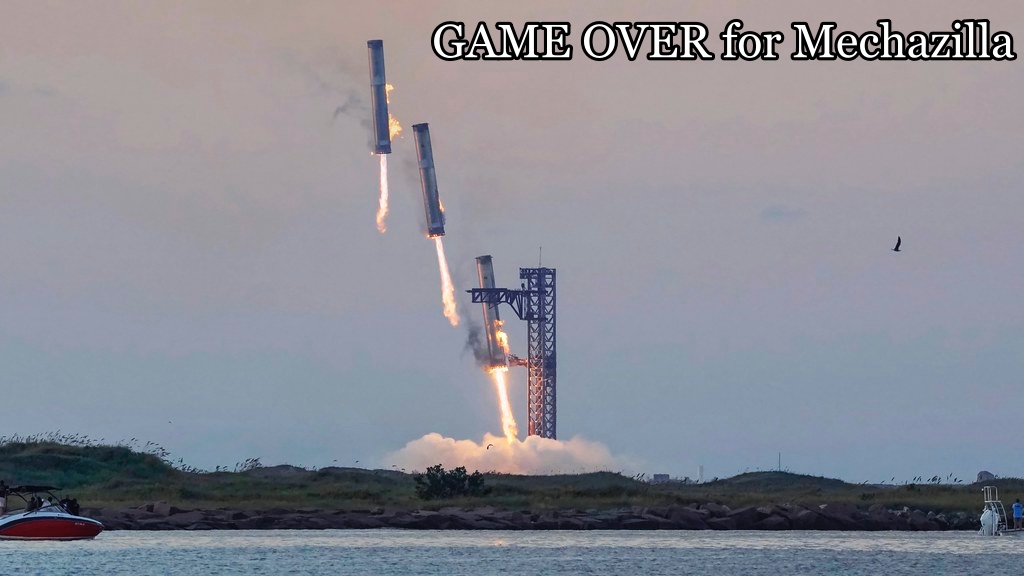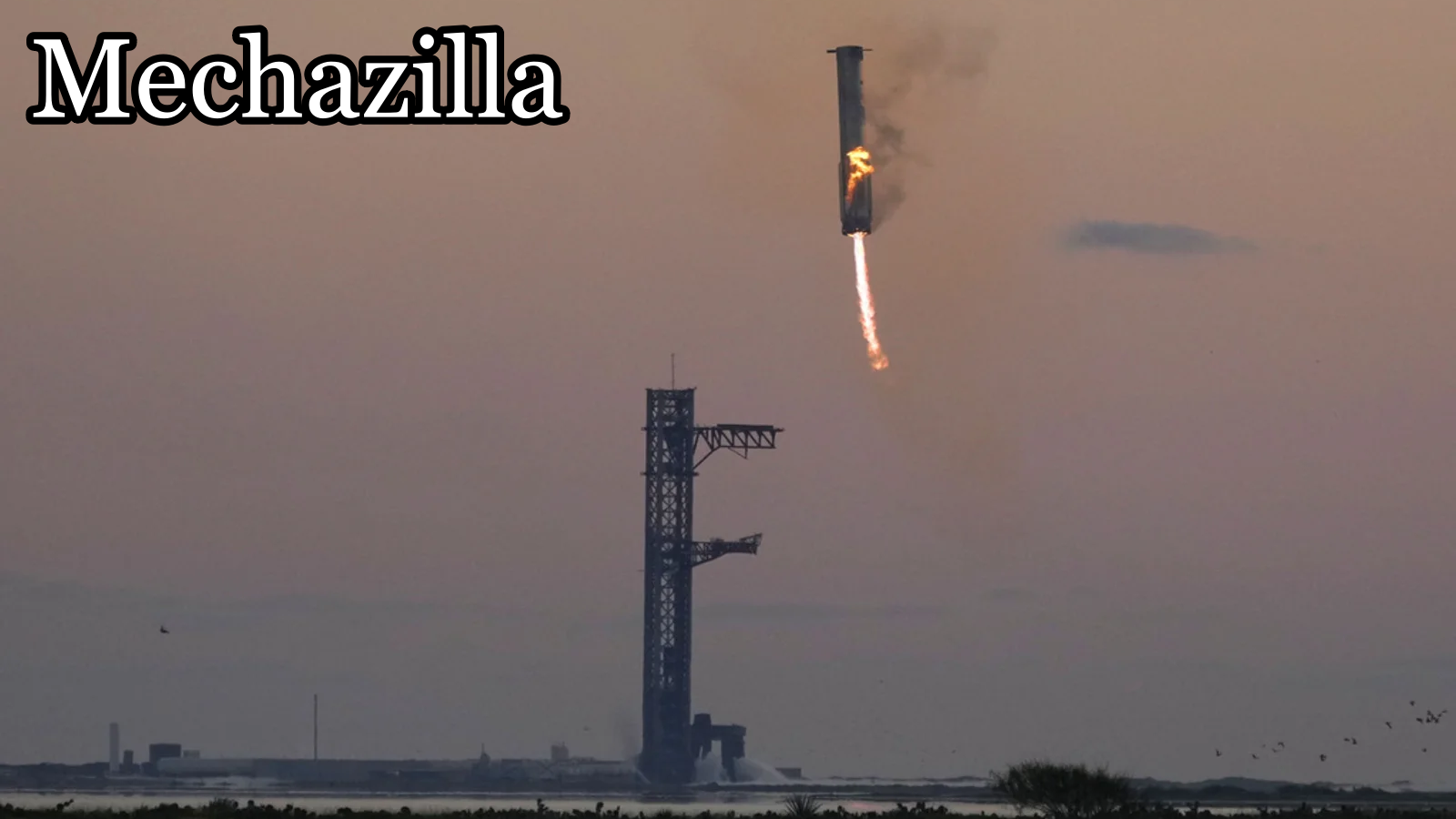At Starbase Texas, a towering rocket—taller than the Statue of Liberty—descends from the sky at breathtaking speed. In less than a decade, SpaceX has completely transformed the space industry, turning what once seemed like science fiction into reality. The idea of catching rockets in midair with mechanical arms, a project known as Mechazilla, has captured the world’s imagination, representing one of the boldest innovations in spaceflight history.
However, as SpaceX pushes the boundaries of what’s possible, they’ve encountered unexpected challenges. In this article, we’ll explore how SpaceX is rethinking their approach to landing both Starship and its massive Super Heavy booster, with a focus on their evolving recovery methods. This strategic shift could completely change how the world’s most powerful rockets are recovered—making space travel more efficient and reliable than ever before.
The Birth of Mechazilla: Catching Rockets with Mechanical Arms
When SpaceX first introduced their vision of Mechazilla, the mechanical arms that would catch Starship’s boosters in midair, it was an elegant but incredibly complex idea. These towering steel arms would reach into the heavens like modern-day Titans, symbolizing humanity’s growing mastery over space technology. But the reality of landing a rocket with such precision was far more challenging than anyone could have anticipated.
Rocket Descent: The Forces at Play
When Super Heavy Starship’s first-stage booster returns from space, it faces more than just gravity. It battles complex aerodynamics, atmospheric turbulence, and the immense energy of its descent. The 33 Raptor engines, each capable of producing 520,000 pounds of thrust, must work in perfect harmony to guide the massive rocket back to its target. But even with this level of power, several critical challenges stood in the way of the Mechazilla concept.

Challenges of Catching Rockets in Midair
1. Timing Precision
Catching a descending rocket requires split-second timing. Even the smallest delay or slight misalignment could result in disaster. Imagine trying to catch a falling pencil by its point, except this “pencil” weighs millions of pounds and is moving at speeds that defy comprehension.
2. Weather Variability
While Texas’s coastal location may seem ideal for launches, its unpredictable winds add another layer of complexity. Even a slight gust can alter the trajectory of the descending rocket, making it nearly impossible to make a successful catch. SpaceX had to carefully factor in these environmental variables as they pushed the boundaries of rocket recovery.
3. Kinetic Energy
When Super Heavy descends, it carries an enormous amount of kinetic energy. This energy must be absorbed and safely dissipated when catching the booster, which presents a paradox for engineers: the mechanical arms need to be strong enough to handle these forces while remaining flexible enough to avoid damaging the booster.
SpaceX’s Hybrid Solution: Evolving Rocket Recovery with Enhanced Drone Ships
Rather than abandoning the idea of rocket recovery, SpaceX has started to embrace a hybrid approach that blends the best aspects of their previous experiences with new innovations. Inspired by their success with Falcon 9, they are developing next-generation drone ships designed specifically for the Starship system.
The New Drone Ships
The new drone ships will need to handle a rocket that’s nearly 10 times heavier than Falcon 9 and generates 10 times more thrust. The engineering challenges involved are immense, but the benefits are worth the effort.
Advanced Stabilization Systems
These systems will help the ships adjust to ocean movement, providing a stable landing surface.
Cutting-edge Heat Shielding
Special materials will protect the ship from the intense heat generated by Starship’s Raptor engines.
Advanced Water Deluge Systems
These systems will manage the heat and energy generated during landing, cooling the landing pad with precisely controlled water flows.
Reimagining the Landing Process
Unlike Falcon 9, which uses a relatively straightforward vertical descent, Starship performs a belly-flop maneuver before transitioning to a vertical landing. This adds complexity to the landing process, requiring advanced guidance systems and landing algorithms that can account for the ship’s aerodynamics and the motion of the ocean platform.
New Autonomous Robots for Rocket Securing
SpaceX is also working on developing new autonomous robots to secure the rocket after landing. Building upon the Octagrabber system used with Falcon 9, these robots will need to be significantly larger and more powerful, capable of safely securing a rocket that’s taller and heavier than anything ever attempted before.
The Path Forward: Making Space Travel More Efficient and Reliable
The success of Starship’s recovery system will be a game-changer for space travel. By making Starship fully reusable, SpaceX is creating the foundation for a reliable, cost-effective space transportation system—one where rockets can be reused with the same frequency and regularity as commercial airplanes.
SpaceX’s Evolving Vision: The Future of Space Travel
While the idea of catching rockets in midair has captured the public’s imagination, SpaceX’s refined approach using advanced drone ships might prove more practical and reliable in the long run. As testing continues and more data is gathered, SpaceX engineers are learning how to manage the forces involved, optimize the landing sequence, and improve the overall reliability of the recovery process.
Each successful landing brings us closer to a future where space missions can be launched with the regularity and reliability of commercial airline flights, dramatically reducing the cost of space travel and making it accessible to more people.
A Vision for Humanity’s Future Among the Stars
The development of Starship is not just about building a spacecraft; it’s about designing humanity’s first true home among the stars. As SpaceX’s vision for a six-level Starship interior takes shape, astronauts will be able to live and work in a highly optimized environment during their long-duration missions.
Starship’s Six-Level Design
The six levels of Starship will include:
- Level One: Power distribution and cargo modules.
- Level Two: A hydroponic garden for food growth and crew morale.
- Level Three: Exercise areas and a medical bay.
- Level Four: Private crew quarters for rest and relaxation.
- Level Five: Research labs, mission planning spaces, and an observation lounge.
- Level Six: The command center, where the entire mission will be controlled.
Optimizing Every Inch of Space
This design optimizes every inch of space, ensuring that Starship isn’t just a rocket—it’s a living, breathing environment capable of supporting life in space for months, or even years, at a time.
The Road Ahead for SpaceX and Starship
SpaceX is not just pushing the boundaries of rocket recovery technology but is also paving the way for humanity’s future in space. Each innovation, whether in landing technology or crew accommodations, brings us closer to a world where space travel is routine and affordable. As the company continues to refine its designs and methods, the Starship project remains humanity’s most ambitious attempt at interplanetary travel.
As we witness the ongoing evolution of SpaceX’s recovery systems and spacecraft, we are also witnessing the birth of humanity’s next giant leap into the cosmos.
Read More:
- SpaceX’s 5-Star Space Station BEATS NASA’s ISS
- Tesla Phone: The Future of Smartphones is Here
- The Ultimate Guide to Tesla Heater: Everything You Need to Know
FAQ
Mechazilla is SpaceX’s innovative concept involving giant mechanical arms that are designed to catch the boosters of Starship mid-air as they descend back to Earth. The arms are intended to safely grab and recover the rocket, allowing for the reusability of boosters for future missions.
Catching a rocket in midair requires split-second precision. Factors such as the speed of descent, wind conditions, and the immense kinetic energy involved make it an incredibly complex task. Even small delays or misalignments could result in catastrophic failure.
The primary challenges with Mechazilla included:
Timing Precision: The mechanical arms must catch the rocket with incredible accuracy, leaving no room for error.
Weather Conditions: Unpredictable winds can push the rocket off course during descent, complicating the catch.
Kinetic Energy: The arms must absorb enormous forces while ensuring the rocket remains undamaged.
SpaceX is evolving toward a hybrid solution that combines Mechazilla’s mechanical arms with next-generation drone ships. These ships are designed to accommodate the massive size and weight of Starship and its Super Heavy booster. They feature advanced stabilization systems, heat shielding, and water deluge systems to handle the intense conditions of rocket landings.
The new drone ships are specifically built to handle Starship’s massive size and ten times more thrust than Falcon 9 rockets. They are equipped with advanced stabilization systems, heat-resistant materials, and a specialized water deluge system designed to withstand the intense heat and forces during landings.
Unlike Falcon 9, which lands vertically, Starship performs a belly-flop maneuver before transitioning to vertical flight for landing. This complex choreography requires advanced guidance systems and landing algorithms to account for both the rocket’s aerodynamics and the ocean platform’s motion.
SpaceX’s design for Starship includes a six-level interior, which incorporates:
Hydroponic gardens for food growth.
Exercise areas and a medical bay to ensure astronauts remain healthy.
Private crew quarters for privacy.
Research labs and observation lounges to maintain crew morale. The interior will be optimized for long-duration missions, making it a functional and livable spacecraft for the journey to the Moon, Mars, and beyond.


1 thought on “GAME OVER for Mechazilla: What SpaceX Just Revealed Will Change Everything”